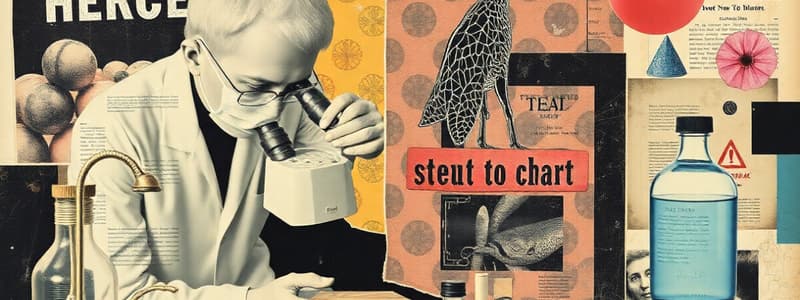Podcast
Questions and Answers
What is the appropriate method for sterilizing reusable materials that have come into contact with high-risk biological samples?
What is the appropriate method for sterilizing reusable materials that have come into contact with high-risk biological samples?
- Washing with water.
- Autoclave sterilization. (correct)
- Washing with soap and water.
What type of forceps should be used to hold glass instruments when removing them from a flame?
What type of forceps should be used to hold glass instruments when removing them from a flame?
- Wooden forceps
- Any available forceps
- Metallic forceps (correct)
How is material used to contain biological samples generally classified?
How is material used to contain biological samples generally classified?
- Low risk
- Medium risk
- High risk (correct)
What is the essential condition of materials used for collecting samples for microbiological analysis?
What is the essential condition of materials used for collecting samples for microbiological analysis?
What should be used to clean reusable laboratory material that contains lipophilic residues?
What should be used to clean reusable laboratory material that contains lipophilic residues?
What equipment is essential for microscopic particle counting?
What equipment is essential for microscopic particle counting?
What is the primary use of Petri dishes in a laboratory setting?
What is the primary use of Petri dishes in a laboratory setting?
Where should the incubation of samples ideally take place?
Where should the incubation of samples ideally take place?
Which of the following is a high-level germicide?
Which of the following is a high-level germicide?
What is the purpose of sterilization as a laboratory procedure?
What is the purpose of sterilization as a laboratory procedure?
Flashcards
Sterilization of contaminated material
Sterilization of contaminated material
Material that has contacted high-risk biological samples must be sterilized to eliminate pathogens.
Sterile sampling material
Sterile sampling material
Sterile material for collecting microbiological samples ensures no contamination affects results.
Petri dish use
Petri dish use
Petri dishes enable long-term preservation of samples for testing.
Sterilizing sample tools
Sterilizing sample tools
Signup and view all the flashcards
Fresh sample microscopy
Fresh sample microscopy
Signup and view all the flashcards
Microscope lenses
Microscope lenses
Signup and view all the flashcards
Microscope stage function
Microscope stage function
Signup and view all the flashcards
Culture media use
Culture media use
Signup and view all the flashcards
Lab assistant job
Lab assistant job
Signup and view all the flashcards
Lab media prep
Lab media prep
Signup and view all the flashcards
Study Notes
- Reusable material that has contacted high-risk biological samples must be sterilized in an autoclave.
- Metallic forceps should be used to hold glass instruments when removing them from heat.
- Material used to contain biological samples is considered high-risk.
- Material for collecting samples for microbiological analysis must be sterile.
- Reusable laboratory material with lipophilic residues needs cleaning with organic solvents.
- Counting chambers are used for microscopic particle counting.
- Petri dishes are used for sample preservation.
- Sample incubation should be done in an incubator.
- Material for taking microbiological samples must be sterilized beforehand.
- Microscopic observation of "fresh" samples should be done with unstained samples.
- The optical part of microscopes consists of two convergent lenses.
- Auramine is used in fluorescence microscopy.
- The microscope stage is used to place the preparation to be observed.
- Dehydrated culture media should be stored between +15 and +26°C.
- Distilled water with a near neutral pH should be used in the preparation of culture media.
- The clarity of culture media is a physico-chemical parameter.
- Culture media are a mixture of substances used for the growth and multiplication of bacteria.
- Sample preparation in the laboratory is a task for a laboratory assistant.
- Cleaning and maintenance of laboratory material falls under the specific duties of a laboratory assistant.
- Preparation of reagents and culture media is among the duties of a laboratory assistant.
- A laboratory coat should always be worn during a work shift when handling biological samples.
- Handling microbiological samples should be done in laminar flow cabinets.
- Sharp disposable material must be discarded in special containers after use.
- Handling flammable reagents requires doing so in fume hoods.
- Radioactive isotopes emit gamma rays.
- Ethylene oxide is a high-level germicide.
- Sterilization aims to eliminate microorganisms and resistant forms (spores).
- Aldehydes and ethylene oxide are chemical agents used as disinfectants and/or sterilizers.
- Pasteur ovens use dry heat for sterilization.
- The Municipal Public Health Laboratory is located on C/ Emigrantes, 20.
Studying That Suits You
Use AI to generate personalized quizzes and flashcards to suit your learning preferences.
Related Documents
Description
Learn about the use of various lab instruments and appropriate sterilization methods for biological samples. High-risk materials require autoclaving. Microscopy techniques and storage guidelines are discussed.



